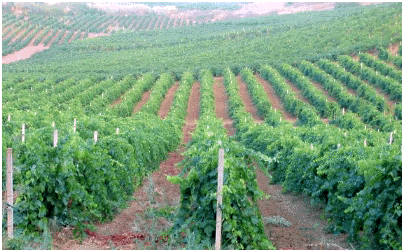...Best of Sicily presents... Best of Sicily Magazine. ... Dedicated to Sicilian art, culture, history, people, places and all things Sicilian. |
by Roberta Gangi | |||||
Magazine Index Best of Sicily Arts & Culture Fashion Food & Wine History & Society About Us Travel Faqs Contact Map of Sicily
|
This is not to suggest that the traditional approach has vanished entirely, just that it isn't always essential to the production of a good wine. Oh, you didn't know that. Well, there are still a few things about viticulture and winemaking that can't credibly be faked. The "noble" part is one of them. In recent years a number of Sicily's aristocratic families have returned to their roots. Not the ones anchoring the family tree, but the agricultural ones linked, quite literally, to the land. Unlike the aristocracies of northern European countries whose prosperity grew out of the Industrial Revolution, Sicily's has always been based on the land, with few forays into industry. Only in 1948 were the large estates of Sicily finally broken into smaller parcels for sale to the rest of the population, and then only with the strong arm of the law enforcing legislation which had been contemplated since the nineteenth century. Out of the dozens of such families in Sicily, we selected the Testas as our example - that's their coat of arms with the boar's head as a play on their surname, which means head in Italian. Mostly, this is because of familiarity with them and their winery near Alcamo, in Sicily's traditional wine country (they occasionally advertise on this website), but also because, when it comes to marketing and promotion, they're not as ridiculously arrogant as some of the families in the business of making Sicilian wine. We also like the idea that the Testa estate, Tarantola, is located in what was historically Sicily's principal wine-growing region, where most of the island's best wines are produced, and not a recently-converted pasture in the shadow of a rocky mountain. Before mentioning a few high points in the Testa history, it should be explained that Sicily's wine industry, as it exists today, is actually a recent thing. Until about thirty years ago, most of Sicily's grapes were destined either for fortified wines like Marsala, or else ended up in France or northern Italy as "blending agents" in regional wines whose "local" grapes (especially the reds) otherwise would not benefit from the sunshine of the endless Sicilian summer. With the latter point we tread upon controversial ground, for what French or Italian winemaker - in either case a proud breed - wants to admit that his wine would be little more than fermented grape juice without the addition of somebody else's more robust must?
While the vines of the Testa estate seem to have been here since time immemorial, they are not as old as the family history would suggest. The oldest ones were planted during the nineteenth century, and most of what you see today is far younger. In earlier centuries there were vineyards here but also fields of grazing land and durum wheat. Even with government price supports and other programmes, viticulture, compared to other agriculture, can be a particularly challenging business. There's no getting around that. Even in Sicily, where the harvest usually begins in late August continuing into September, an unseasonably heavy rainstorm can destroy a good part of an estate's grapes on the vine - a potential catastrophe that doesn't threaten wheat growers. Uunder the best circumstances the production of agricultural products such as wine and olive oil, apart from technical considerations, entails at least as much effort and risk as anything else an agriculturalist might grow. Profit margins vary from firm to firm, but for Sicilian wines, which rarely fetch more that ten or twelve euros per bottle at retail (in Italy), the road to riches is not paved with anything even remotely resembling gold. The estate produces several wines under the Gorgo del Drago label - an Inzolia-Chardonnay, a Cabernet-Syrah, and a distinctively Sicilian Nero d'Avola. Sicily's native varieties work well with international ones. Nero d'Avola is in a category of its own, a full-bodied red that devotees of Syrah will appreciate. Diversifying somewhat, the estate also produces preserves and olive oil. It has a restaurant that serves the local cuisine, made from produce grown organically on the farm alongside the vineyards. There are also accomodations for overnight guests - part of a trend that Italians call agriturismo that opens private country retreats like Tarantola to visitors as a kind of country bed and breakfast. This versatile approach is not unique to Sicily, but it has the virtue of operating on the island's two most important private-sector fronts: agriculture and various aspects of tourism. As manufacturing, high technology and service industries are largely underdeveloped in Sicily's economy (except for the occasional call centre), these two areas surpass all others in productivity and profits. With the astounding number of business failures in Sicily, it's nice to know that there are at least a few enterprises that function as they were meant to. The aristocratic element in all this is more about the dedication and potential efficiency of a family-run business than being descended from generations of titled ancestors. Under the direction of Count Filippo Testa, Tarantola doesn't engage in a lot of outsourcing, such as purchasing the grapes of other vineyards. It's a "self-contained" business, and it takes hard work to make it successful. That alone makes it stand out from many other agricultural enterprises. Most Sicilians involved in this kind of agriculture are a hardy lot. They have to be. About the Author: Roberta Gangi has written numerous articles and one book dealing with Italian cultural and culinary history, and a number of food and wine articles for Best of Sicily Magazine. | ||||
Top of Page |

 Whether it's
the vintage white of a French chateau or the estate-bottled Italian red
meant to be uncorked and enjoyed within a few years of its creation, the
prestige - or at least the brand identity - of a fine wine seems to be enhanced
when the buying public perceives that there's some history behind both the
wine and its vintner. This is winemaking as a noble art. The grapes crushed under
the bare feet of young country girls, then fermented in aged oak
barrels in the thick-walled keep of a centuries-old castle. Bottles stored
in a secret cellar reached through ancient archways, steep steps and narrow passages. That sort of
thing. So powerful is this archetypal image that it would be a shame to
shatter it by mentioning pressing equipment, huge stainless steel tanks,
tubes and digital gauges. (Sorry about that.)
Whether it's
the vintage white of a French chateau or the estate-bottled Italian red
meant to be uncorked and enjoyed within a few years of its creation, the
prestige - or at least the brand identity - of a fine wine seems to be enhanced
when the buying public perceives that there's some history behind both the
wine and its vintner. This is winemaking as a noble art. The grapes crushed under
the bare feet of young country girls, then fermented in aged oak
barrels in the thick-walled keep of a centuries-old castle. Bottles stored
in a secret cellar reached through ancient archways, steep steps and narrow passages. That sort of
thing. So powerful is this archetypal image that it would be a shame to
shatter it by mentioning pressing equipment, huge stainless steel tanks,
tubes and digital gauges. (Sorry about that.) Getting back to the Testas, their history isn't too different from those
of many other families of their class. In the sixteenth century a Testa obtained
the barony of San Basilio, thereby becoming a baron through possession of
feudal property. His descendant, a certain Giovanni Testa, became a count
of the Holy Roman Empire in 1653. At first glance this would seem a bit
odd, as Austria isn't exactly next door and Testa
is so obviously an Italian name. It has to do with the Hapsburgs
who then ruled Sicily and Spain, being Holy Roman Emperors as well. In
the event, this particular title obviated the need for elevating the family's humble barony to a county,
as the new rank, though impressive, entailed no land or feudal rights. Being a
count used to count for more than it does now.
Getting back to the Testas, their history isn't too different from those
of many other families of their class. In the sixteenth century a Testa obtained
the barony of San Basilio, thereby becoming a baron through possession of
feudal property. His descendant, a certain Giovanni Testa, became a count
of the Holy Roman Empire in 1653. At first glance this would seem a bit
odd, as Austria isn't exactly next door and Testa
is so obviously an Italian name. It has to do with the Hapsburgs
who then ruled Sicily and Spain, being Holy Roman Emperors as well. In
the event, this particular title obviated the need for elevating the family's humble barony to a county,
as the new rank, though impressive, entailed no land or feudal rights. Being a
count used to count for more than it does now.